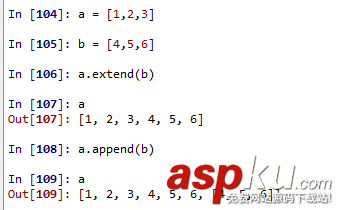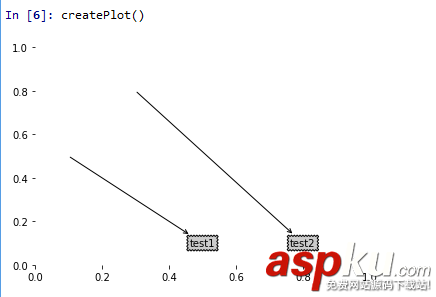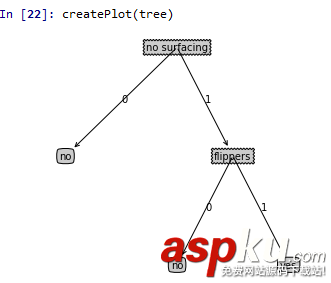决策树原理:从数据集中找出决定性的特征对数据集进行迭代划分,直到某个分支下的数据都属于同一类型,或者已经遍历了所有划分数据集的特征,停止决策树算法。
每次划分数据集的特征都有很多,那么我们怎么来选择到底根据哪一个特征划分数据集呢?这里我们需要引入信息增益和信息熵的概念。
一、信息增益
划分数据集的原则是:将无序的数据变的有序。在划分数据集之前之后信息发生的变化称为信息增益。知道如何计算信息增益,我们就可以计算根据每个特征划分数据集获得的信息增益,选择信息增益最高的特征就是最好的选择。首先我们先来明确一下信息的定义:符号xi的信息定义为 l(xi)=-log2 p(xi),p(xi)为选择该类的概率。那么信息源的熵H=-∑p(xi)·log2 p(xi)。根据这个公式我们下面编写代码计算香农熵
def calcShannonEnt(dataSet): NumEntries = len(dataSet) labelsCount = {} for i in dataSet: currentlabel = i[-1] if currentlabel not in labelsCount.keys(): labelsCount[currentlabel]=0 labelsCount[currentlabel]+=1 ShannonEnt = 0.0 for key in labelsCount: prob = labelsCount[key]/NumEntries ShannonEnt -= prob*log(prob,2) return ShannonEnt上面的自定义函数我们需要在之前导入log方法,from math import log。 我们可以先用一个简单的例子来测试一下
def createdataSet(): #dataSet = [['1','1','yes'],['1','0','no'],['0','1','no'],['0','0','no']] dataSet = [[1,1,'yes'],[1,0,'no'],[0,1,'no'],[0,0,'no']] labels = ['no surfacing','flippers'] return dataSet,labels

这里的熵为0.811,当我们增加数据的类别时,熵会增加。这里更改后的数据集的类别有三种‘yes'、‘no'、‘maybe',也就是说数据越混乱,熵就越大。

分类算法出了需要计算信息熵,还需要划分数据集。决策树算法中我们对根据每个特征划分的数据集计算一次熵,然后判断按照哪个特征划分是最好的划分方式。
def splitDataSet(dataSet,axis,value): retDataSet = [] for featVec in dataSet: if featVec[axis] == value: reducedfeatVec = featVec[:axis] reducedfeatVec.extend(featVec[axis+1:]) retDataSet.append(reducedfeatVec) return retDataSet
axis表示划分数据集的特征,value表示特征的返回值。这里需要注意extend方法和append方法的区别。举例来说明这个区别

下面我们测试一下划分数据集函数的结果:

axis=0,value=1,按myDat数据集的第0个特征向量是否等于1进行划分。
接下来我们将遍历整个数据集,对每个划分的数据集计算香农熵,找到最好的特征划分方式
def choosebestfeatureToSplit(dataSet): Numfeatures = len(dataSet)-1 BaseShannonEnt = calcShannonEnt(dataSet) bestInfoGain=0.0 bestfeature = -1 for i in range(Numfeatures): featlist = [example[i] for example in dataSet] featSet = set(featlist) newEntropy = 0.0 for value in featSet: subDataSet = splitDataSet(dataSet,i,value) prob = len(subDataSet)/len(dataSet) newEntropy += prob*calcShannonEnt(subDataSet) infoGain = BaseShannonEnt-newEntropy if infoGain>bestInfoGain: bestInfoGain=infoGain bestfeature = i return bestfeature
信息增益是熵的减少或数据无序度的减少。最后比较所有特征中的信息增益,返回最好特征划分的索引。函数测试结果为

接下来开始递归构建决策树,我们需要在构建前计算列的数目,查看算法是否使用了所有的属性。这个函数跟跟第二章的calssify0采用同样的方法
def majorityCnt(classlist): ClassCount = {} for vote in classlist: if vote not in ClassCount.keys(): ClassCount[vote]=0 ClassCount[vote]+=1 sortedClassCount = sorted(ClassCount.items(),key = operator.itemgetter(1),reverse = True) return sortedClassCount[0][0]def createTrees(dataSet,labels): classList = [example[-1] for example in dataSet] if classList.count(classList[0]) == len(classList): return classList[0] if len(dataSet[0])==1: return majorityCnt(classList) bestfeature = choosebestfeatureToSplit(dataSet) bestfeatureLabel = labels[bestfeature] myTree = {bestfeatureLabel:{}} del(labels[bestfeature]) featValue = [example[bestfeature] for example in dataSet] uniqueValue = set(featValue) for value in uniqueValue: subLabels = labels[:] myTree[bestfeatureLabel][value] = createTrees(splitDataSet(dataSet,bestfeature,value),subLabels) return myTree最终决策树得到的结果如下:

有了如上的结果,我们看起来并不直观,所以我们接下来用matplotlib注解绘制树形图。matplotlib提供了一个注解工具annotations,它可以在数据图形上添加文本注释。我们先来测试一下这个注解工具的使用。
import matplotlib.pyplot as pltdecisionNode = dict(boxstyle = 'sawtooth',fc = '0.8')leafNode = dict(boxstyle = 'sawtooth',fc = '0.8')arrow_args = dict(arrowstyle = '<-')def plotNode(nodeTxt,centerPt,parentPt,nodeType): createPlot.ax1.annotate(nodeTxt,xy = parentPt,xycoords = 'axes fraction',/ xytext = centerPt,textcoords = 'axes fraction',/ va = 'center',ha = 'center',bbox = nodeType,/ arrowprops = arrow_args) def createPlot(): fig = plt.figure(1,facecolor = 'white') fig.clf() createPlot.ax1 = plt.subplot(111,frameon = False) plotNode('test1',(0.5,0.1),(0.1,0.5),decisionNode) plotNode('test2',(0.8,0.1),(0.3,0.8),leafNode) plt.show() 
测试过这个小例子之后我们就要开始构建注解树了。虽然有xy坐标,但在如何放置树节点的时候我们会遇到一些麻烦。所以我们需要知道有多少个叶节点,树的深度有多少层。下面的两个函数就是为了得到叶节点数目和树的深度,两个函数有相同的结构,从第一个关键字开始遍历所有的子节点,使用type()函数判断子节点是否为字典类型,若为字典类型,则可以认为该子节点是一个判断节点,然后递归调用函数getNumleafs(),使得函数遍历整棵树,并返回叶子节点数。第2个函数getTreeDepth()计算遍历过程中遇到判断节点的个数。该函数的终止条件是叶子节点,一旦到达叶子节点,则从递归调用中返回,并将计算树深度的变量加一
def getNumleafs(myTree): numLeafs=0 key_sorted= sorted(myTree.keys()) firstStr = key_sorted[0] secondDict = myTree[firstStr] for key in secondDict.keys(): if type(secondDict[key]).__name__=='dict': numLeafs+=getNumleafs(secondDict[key]) else: numLeafs+=1 return numLeafsdef getTreeDepth(myTree): maxdepth=0 key_sorted= sorted(myTree.keys()) firstStr = key_sorted[0] secondDict = myTree[firstStr] for key in secondDict.keys(): if type(secondDict[key]).__name__ == 'dict': thedepth=1+getTreeDepth(secondDict[key]) else: thedepth=1 if thedepth>maxdepth: maxdepth=thedepth return maxdepth
测试结果如下

我们先给出最终的决策树图来验证上述结果的正确性

可以看出树的深度确实是有两层,叶节点的数目是3。接下来我们给出绘制决策树图的关键函数,结果就得到上图中决策树。
def plotMidText(cntrPt,parentPt,txtString): xMid = (parentPt[0]-cntrPt[0])/2.0+cntrPt[0] yMid = (parentPt[1]-cntrPt[1])/2.0+cntrPt[1] createPlot.ax1.text(xMid,yMid,txtString) def plotTree(myTree,parentPt,nodeTxt): numLeafs = getNumleafs(myTree) depth = getTreeDepth(myTree) key_sorted= sorted(myTree.keys()) firstStr = key_sorted[0] cntrPt = (plotTree.xOff+(1.0+float(numLeafs))/2.0/plotTree.totalW,plotTree.yOff) plotMidText(cntrPt,parentPt,nodeTxt) plotNode(firstStr,cntrPt,parentPt,decisionNode) secondDict = myTree[firstStr] plotTree.yOff -= 1.0/plotTree.totalD for key in secondDict.keys(): if type(secondDict[key]).__name__ == 'dict': plotTree(secondDict[key],cntrPt,str(key)) else: plotTree.xOff+=1.0/plotTree.totalW plotNode(secondDict[key],(plotTree.xOff,plotTree.yOff),cntrPt,leafNode) plotMidText((plotTree.xOff,plotTree.yOff),cntrPt,str(key)) plotTree.yOff+=1.0/plotTree.totalD def createPlot(inTree): fig = plt.figure(1,facecolor = 'white') fig.clf() axprops = dict(xticks = [],yticks = []) createPlot.ax1 = plt.subplot(111,frameon = False,**axprops) plotTree.totalW = float(getNumleafs(inTree)) plotTree.totalD = float(getTreeDepth(inTree)) plotTree.xOff = -0.5/ plotTree.totalW; plotTree.yOff = 1.0 plotTree(inTree,(0.5,1.0),'') plt.show()
以上就是本文的全部内容,希望对大家的学习有所帮助,也希望大家多多支持VEVB武林网。
新闻热点
疑难解答